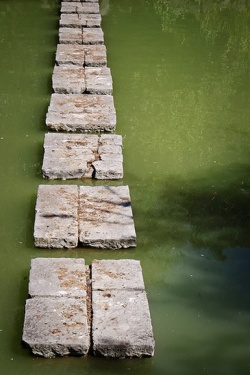Yeshe Bumpa
The fifth abbot of Katok, Yeshe Bumpa (ye shes 'bum pa) was born at a place called Yenpa (g.yen pa) in 1242, the water-tiger year of the fourth sexagenary cycle. Nothing is known about his parents or childhood. It can be assumed that he was given monastic vows at Katok Monastery by the fourth abbot of Katok, Chenngawa Sonam Bumpa (spyan snga ba bsod nams 'bum pa, 1222-1282) under whom he studied.
At the age of about forty-one, in 1282, Yeshe Bumpa was enthroned as the fifth abbot of Katok, and successor of Chenngawa Sonam Bumpa. He taught both Sūtra and Tantra, particularly the three higher yogas as classified by the Nyingma tradition: Mahāyoga, Anuyoga, and Atiyoga/Dzogchen. Because of his scholarship in these profound yogas and their practices he was later known as the Katokpa U-wo-wa Yeshe Bumpa (dbu 'od ba ye shes 'bum pa), meaning Yeshe Bumpa, the Bright Head of Katok, and became well-known in Kham and throughout Tibet.
Yeshe Bumpa trained a large number of students from Kham and from the U and Tsang regions; tradition gives the number of 180,000, which is certainly hyperbole. It was further said that over a hundred of his disciples accomplished the rainbow-body.
According to legend, once Yeshe Bumpa was invited to the consecration ceremony of a newly build Mahākāla temple called Namgyel Gonkhang in Dzing ('dzing gi rnam rgyal mgon khang), to which a number of Sakya lamas were also invited. “I, a tantric master who follows the Old Translation Tantra, will dispel and subdue all evil spirits and obstacles. You, followers of the New Translation Tantra, will be better at performing consecration rituals.” They divided the work accordingly, and during the ceremony Yeshe Bumpa had the opportunity to confer Guhyagarbha empowerment on Drogon Chogyel Pakpa Lodro Gyeltsen ('gro mgon chos rgyal 'phags pa blo gros rgyal mtshan, 1235-1280).
Later, while on his way back to Tibet from China, Pakpa visited Katok to see Yeshe Bumpa and offered him gifts from China, including a large bronze stupa, a set of seven water-offering bowls (ting bdun tshar) and other valuable items.
Yeshe Bumpa retired from the abbot's seat in 1327 and enthroned Jangchub Bumpa (byang chub 'bum pa, 1284-1347) as his successor. Soon thereafter, in February 1328, he passed into nirvana, on a date given as the twenty-second day of the twelfth month of the first year in the sixth sexagenary cycle, the fire-hare year. He was eighty-six. One source has it that he passed away at the age of seventy-four but this must be incorrect as the year of death mentioned in this source is same as the above.
Yeshe Bumpa was the second among the three famous Bumpa lamas of Katok Monastery. His reliquary was installed with Choje, the founder and his two immediate disciples in Kumbum (sku 'bum).
Sources
'Jam dbyangs rgyal mtshan. 1996. Rgyal ba kaH thog pa’i lo rgyus mdor bsdus. Chengdu: Si khron mi rigs dpe skrun khang, pp. 42-44.
Samten Chhosphel April 2011
